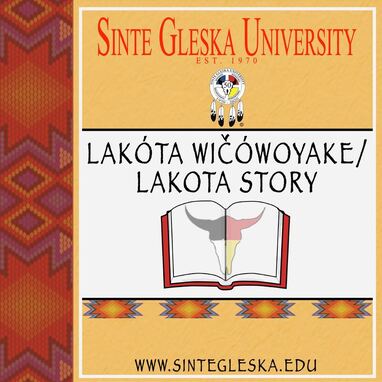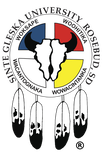|
Šahiyela Kiŋ Wawákaŋ Ičupí
Ṕíspiza otí waḱpála kiŋ he mahe iyeye ḱel ewíčoti na Šahiyela na Mah́píyato na Laḱota ko wičotí. Na waŋna aŋpetu waŋ el Šahiyela kiŋ wawákaŋ ičupi kta keyápi. Na hočokam típi iyákiju iyáh́peyapi na emničiya. Na waŋna wičaša waŋ šina hiŋ iákataŋ glówiŋ ča waŋna híŋaṕa na típi kiŋ le itáwokšaŋ wauŋyaŋpi tatíye tópa kiŋ owašiŋ paslátapi. Na wičaša k’oŋ waŋna lówaŋ na waŋkal etoŋwaŋ uŋ na ečel líla wakíŋyaŋ aglí. Na wičaša waŋ najiŋ k’oŋ el owótan’iŋ šni na káska iyáya na heče na oyáte kiŋ waŋyank najiŋpi na ečel atan’iŋ. Yuŋkaŋ itázipa waŋ líla haŋska ča yúha najiŋ na wahiŋḱpe waŋ líla haŋska ča nakuŋ iyágna. Na ečel waŋna lówaŋ na itazípa k’oŋ tátiye tópa kiŋ owásiŋ epázo. Na waŋna eyápaha waŋ el í na kiči najiŋ na táku okíyaka. Yuŋkaŋ lečel eya: Eyápaha : Le Šahíyela kiŋ yúha oyáte kaǵapi kte lo, na waŋna wawákaŋ kiŋ le yeyíŋ kta ča taŋyaŋ ablez nayájiŋpi kte lo. Na heyáb inájiŋ na wičaša k’oŋ ake lowan na ítazipa k’oŋ ečel iču na wahiŋḱpe k’oŋ ečel iču na tatúye tópa kiŋ ečel akáta na waŋna ena waŋkátakíya íyeya. Yuŋkaŋ iyóyaŋp híŋgla na taŋwáŋkatuya ya na waŋna makáta glíhaŋ. Na oyáte kiŋ waŋyank wičašipi ča waŋyáŋkapi. Yuŋkaŋ hučaŋ, čokaŋyaŋ heháŋyaŋ, atáya we oha. Yuŋkaŋ lečel wičaša kiŋ eya: Wičaša : le líla wanišečapi kta ča híhaŋna kiŋ wanáse ya po, na le wahiŋḱpe kiŋ toháŋl aničih́aŋpi ča oyáte kiŋ wítaya šna lápi na yeyápi kte lo, na le tohaŋ mat’e eša hehaŋl tokeča waŋji yúha kta; tóhaŋyaŋ iníčaǵapi kiŋ heháŋyaŋ luhápi kta. Na tokša túwa le mak’u kiŋhaŋ he tókel ečamoŋ kta hena omákiyaka, ate hena táwa. Ho waŋna hečeglala ča hiŋhaŋ kiŋ wanáse ya po na takúŋni ih́peyapi šni yo. Hečel waŋna kíblečahaŋpi na híhaŋna el waŋna wánase áya na páha waŋ eyáhe eháŋl kaówiŋh eyáya na pte óta yelo eyápi; na waŋna bu wičahiŋgla ča miš kákel ínawape eháŋl ekta ewátoŋwaŋ. Yuŋkaŋ tóhaŋya ištayeyápi heháŋyaŋ pte kiŋ au. Na waŋna wakúwapi na líla wičaópi, na wágliagli. Hehaŋl híhaŋna el Laḱota kiŋ H́eSapa etkíya ukíya ča ake el owáṕa. Na heháŋtaŋ waŋna waníyetu ota ítahena eša leháŋyaŋ nahah́či yúhapi. Hečel wówakaŋ kiŋ le slólwaya. Cheyenne Reception of Sacred Arrows They were encamped where prairie dog dens are located dug into a creek bottom ridge: the Cheyenne, Arapaho, and the Lakota too pitched camp. The Cheyenne one day stated that they would receive sacred arrows. They set up tents fitted together and gathered for a meeting. And a man came out who had put skin blankets around the outside of his tent, while around this tent were set posts in all four directions for offerings. The man sang, was gazing to the sky, and so it was heavy thunder came. And a man who had stood there was not evident, and he left becoming clear; consequently the people stood looking, and then he became visible. He stood holding a very long bow, and with it also a very long arrow. And so he sang and directed the bow in all the four directions. An announcer went over to him, stood with him, and he said something to him. Then he said: Announcer : With the Cheyenne, a tribe shall be created, and you will come to understand this arrow that he will send off. He stood aside while the man again sang, took the bow so, took the arrow thus, plied the bow in the four directions so, and he sent the arrow directly skyward. Then suddenly the arrow glowed with light as it went exceedingly high and coming back and stuck in the ground. The people who were told to watch saw it. Then the arrow shaft, halfway up, was entirely stained with blood. The man now then said: Man : Go to the buffalo hunt tomorrow morning, so you now might get very well provisioned, and when you are hungry let your people always go together and send off this arrow. And now whenever I die then another should carry the arrow; as long as you increase you should keep it. And if one now gives it to me he tells me how I should do things; these belong to the Great Spirit. Well now, when it is no longer snowing, set out for the hunt, and nothing is to be disposed of. So the meeting broke up, they set out on the hunt in the morning, then getting up on the ridge they then went and turned back and said there are lots of buffalo; and since there was a sudden grunting noise, I went out in that direction to take a look at them. As far as the eye can see there were buffalo coming. They gave the chase, shot many, and went home carrying the buffalo meat. In the morning then, when the Lakotas went off toward the Black Hills I again joined them. From that time, though since many winters, yet to this day they have the arrow. So I have known of this sacred object.
0 Comments
|
Strengthening the Circle :
|
- About
- Quick Links
- News
- Governance
- Discover SGU
-
Student Life
- Facts and Figures
- Online Learning Support
- New Student Info/Registration
- Research Review Board >
- 2023 Graduation Ceremony
- 2023 Graduate Photos
- Student Association
- Literacy Center
- Disability Services
- Counseling Services
- Child Care
- Transportation
- Security
- Bookstore
- Library
- Web Mail
- What You Can Do At SGU
- Poll
- Student Opportunities
- After Graduation
-
Departments
- Staff
- Giving
- Board Minutes
Mailing Address: Po Box 105/Mission, SD/57555
Shipping Address: 101 Antelope Lake Circle/Mission,SD/57555
605-856-8100
Shipping Address: 101 Antelope Lake Circle/Mission,SD/57555
605-856-8100
Accreditation and Sinte Gleska University – A Short History
Sinte Gleska University has been accredited by the Higher Learning Commission (HLC – formerly the North Central Association) since 1983. Because SGU is accredited, colleges and universities across the United States will review courses that students take at SGU and will consider them for transfer.
For more information, and to see the most recent correspondence from HLC to SGU, click on the HLC logo
Sinte Gleska University has been accredited by the Higher Learning Commission (HLC – formerly the North Central Association) since 1983. Because SGU is accredited, colleges and universities across the United States will review courses that students take at SGU and will consider them for transfer.
For more information, and to see the most recent correspondence from HLC to SGU, click on the HLC logo
All Media on this site ©2023 Sinte Gleska University.
Do not use without permission. Sinte Gleska University and the Sinte Gleska University Logo are Protected and Registered Trademarks.
Not to be used without permission.See HERE for legal information
Do not use without permission. Sinte Gleska University and the Sinte Gleska University Logo are Protected and Registered Trademarks.
Not to be used without permission.See HERE for legal information


 RSS Feed
RSS Feed
